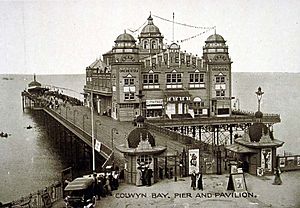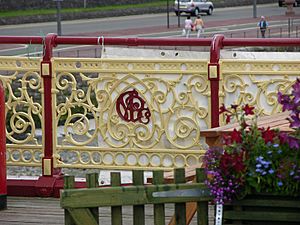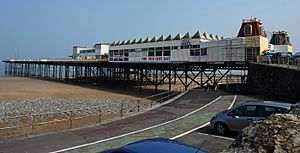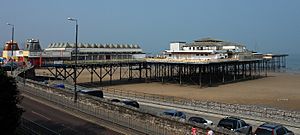Victoria Pier facts for kids
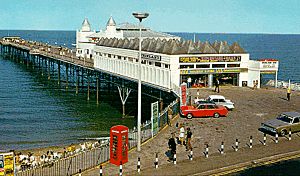
Victoria Pier in the 1970s
|
|
| Official name | Victoria Pier |
|---|---|
| Type | Pleasure Pier |
| Locale | Colwyn Bay, Wales |
| Design | Mangnall & Littlewoods |
| Construction | Widnes Iron Foundry, William Brown & Sons |
| Owner | Conwy County Borough Council |
| Total length | 750ft (227m) |
| Opening date | 1 June 1900 |
The Victoria Pier was a famous pier in Colwyn Bay, Wales. A pier is like a long walkway built out over the water. Even though most of it has been taken down, some of its metal parts are still there. These parts are protected as a special historic building. The local council, Conwy County Borough Council, plans to rebuild part of the pier in 2019.
The pier was designed by Mangnall and Littlewoods. It first opened in 1900. Later, in 1903, it was made longer, reaching 227 meters. The first two main buildings on the pier, called pavilions, burned down. A smaller theatre also caught fire. A third pavilion was built in 1934. It was made much bigger in the 1970s to hold a nightclub and an arcade.
From the late 1980s, the pier started to get old and worn out. The part of the pier over the sea had to close because it was unsafe. The pier kept getting worse until it closed for good in 2008. There was a long legal fight between the pier's private owner and the council. By 2013, the pier was in danger of falling apart. A local group tried to get money to rebuild it, but they didn't succeed.
In 2017, a part of the pier fell onto the beach. Dangerous sections were then taken down. The council and a charity group agreed on a new plan to build a shorter pier.
Contents
Building the Victoria Pier
The Victoria Pier in Colwyn Bay was one of the last piers built in Britain. It was designed by Mangnall & Littlewoods from Manchester. Building started in June 1899 by William Brown & Sons. Many parts of the pier were made in a factory beforehand. This is called "pre-fabricated." These parts came from the Widnes Iron Foundry.
The pier officially opened on June 1, 1900. The architect, Mr. Littlewood, gave a golden key to the owners. When it first opened, the pier was 316 feet long and 40 feet wide. It had a wooden walkway with seats and railings. There was also a large building called a pavilion that could seat 2,500 people. This pavilion was built in a special style called Moorish Revival.
The pavilion was on the right side of the pier. A walkway on the left led to the end of the pier. Inside the pavilion, there was a flower shop on one side. On the other side, there was a coffee and cake shop. The pavilion also had a big balcony and a place for an orchestra. The pier never had a place for boats to dock.
In 1903, the Victoria Pier Company decided to make the pier longer. It reached 750 feet so that outdoor shows could be held. The pier had fancy cast iron railings. These were also made by the Widnes Iron Foundry. Similar railings can be seen at Mumbles Pier. They were also once at Grand Pier, Weston-super-Mare and Morecambe's Central and West End Piers.
Fires and Rebuilding
In 1917, a small theatre called the 'Bijou' theatre was built at the end of the pier. It could seat 600 people and was used for fun shows. Sadly, the first main pavilion building was completely destroyed by fire in 1922.
After the fire, the Victoria Pier Company had money problems. So, the local council bought the pier. They started rebuilding the pavilion right away. In July 1923, the second pavilion opened. It cost £45,000. But disaster struck again on May 16, 1933. The second pavilion was also destroyed by fire. Then, on July 28, 1933, another fire destroyed the Bijou Theatre.
The Third Pavilion and Its Changes
The council decided to rebuild again. The third pavilion opened on May 8, 1934. It cost £16,000. However, the Bijou Theatre was never rebuilt. This new pavilion was designed by architect Stanley Davenport Adshead. The rebuilding also included a covered walkway made of cast iron that led to the pavilion. A bandstand was also built near the pavilion.
More and more people started visiting the pier. So, in 1936, the council started charging a small fee of two pence to enter. This fee included a deckchair and listening to the band. The council said this fee was to stop people from just "lounging" around. Inside the pavilion, shows like 'The Colwyn Follies' were performed.
During the 1950s and 1960s, the pier slowly started to decline. In 1953, the pavilion's tearoom, which had been open all year, started closing for winter. In 1956, the pavilion offered different entertainment each night:
- Monday: bingo
- Tuesday: wrestling
- Wednesday: amateur talent show
- Thursday: old-time dancing
- Friday: popular dance
- Saturday: young people's dance
By 1958, the summer variety shows in the pavilion ended. In 1959, a small orchestra of six musicians replaced them. Over 20,000 people paid to hear them in the afternoons that year. Another 10,000 came in the evenings.
By 1961, fewer people were coming. The council had to reduce the orchestra to three musicians. In 1962, the council stopped live music and played recorded orchestral music instead. The pier had some small repairs in 1964. A small arcade was built at the end of the pier. Both the arcade and the bandstand were removed in the 1970s.
Modernisation in the 1970s
In 1968, a company called Entam Leisure bought the pier from the local council for £59,000. Entam Leisure believed the pier needed to be updated to do well. They built a large new building for the Golden Goose Amusements. They also opened the Golden Fry Restaurant in the old tearooms. The pavilion was turned into the Dixieland Showbar.
As part of these changes, the fancy toll booths at the pier entrance were removed. This made the entrance more open. In the 1970s and 1980s, the Dixieland Showbar held many live concerts. Famous bands like Motörhead, The Damned, Siouxsie & The Banshees, Elvis Costello, Slade, The Specials, Cockney Rejects and Black Flag played there.
In 1979, the pier was sold again to Parker's Leisure. They changed the Dixieland Showbar into CJ's Nightclub. They also added an extension to the Golden Goose Amusements to make a bigger entrance and arcade area.
Decline and Closure
In 1987, the entire end of the pier over the sea was closed to the public. This was because it was unsafe. In 1991, Parkers Leisure closed their arcade and disco businesses on the pier. After it closed, vandals attacked the pier. They broke most of the windows in the old Golden Goose Amusements. They also broke into the pavilion and set it on fire. In 1993, the council allowed the pavilion and the seaward end of the pier to be torn down. However, this work was never done.
In August 1994, there was new hope for the pier. A marine engineer named Mike Paxman bought it. He said he wanted to make it look new again. Mr. Paxman repaired the pier's wooden deck. He divided the old Golden Goose Amusements building into smaller businesses. These included a bar, a cafe, shops, and arcades. They opened on April 1, 1996. He also wanted to reopen the pavilion as a nightclub, but he didn't have enough money. During this time, the pier was shown in an episode of the TV show Hetty Wainthropp Investigates in January 1998. Mr. Paxman eventually tried to sell the pier on eBay in 2003, but it didn't sell.
On December 11, 2003, a businessman named Steve Hunt bought the pier. He sold his house to pay the £100,000 price. He reopened the pier on January 17, 2004. He planned to slowly fix the old structure. He was especially interested in restoring the pier's Art Deco pavilion, which was built in 1933.
In 2008, the entrance building had a fishing shop, a cafe, and a bar. The bar was made bigger and renamed 'Oddities'. There were also some arcade machines. The pavilion hosted special events, like a popular art exhibition. A small part of the pier walkway was open to the public. This area mainly had outdoor seating for the bar. The main part of the pier walkway was closed to the public. However, people could go there for fishing if they bought a permit.
The pier closed at the end of July 2008. This happened because the owner, Steve Hunt, went bankrupt. He owed money to the council for business rates. Mr. Hunt tried to cancel the bankruptcy order, but he couldn't. So, the pier stayed closed. A TV show called Pier Pressure was shown on BBC2 Wales in December 2008. It followed Steve Hunt's efforts to save and fix the Victoria Pier for a year.
Plans to Restore the Pier
In 2012, Conwy County Borough Council bought the pier. They planned to let a local community group manage it if the group succeeded. In March 2012, the council announced they would ask for lottery money to save the pier. However, their request was turned down. The pier remained in bad shape. Fences blocked people from going under the pier for safety reasons.
In 2013, a local community group called Colwyn Bay Shore Thing tried to save the pier again. This group worked with the council. They successfully applied for a first grant from the Heritage Lottery Fund. But their second application was denied in 2015. The Lottery Fund said a big reason for this was that the council refused to support the second application due to costs. After this refusal, the council said they would remove the pier's special historic status and tear it down.
Many people protested this decision. CADW Welsh Heritage, a group that protects historic places in Wales, refused to give permission for demolition.
First Stage of Restoration
The last 45 meters of the pier's seaward end collapsed in two parts. The first collapse was on February 1, 2017, and the second was on February 23.
On March 2, 2017, a council meeting agreed to support the first stage of restoration. This plan, put forward by the Colwyn Victoria Pier Trust, included a shorter pier and a new pavilion. The dangerous seaward part of the pier, about half its length, was removed in March 2017. A section of the pier's deck near the pavilion, which was also collapsing, was taken down. The council then asked for permission to remove the remaining buildings. They also wanted to take apart and store the pier. Their long-term goal was to work with the Victoria Pier Trust to rebuild the historic structure later.
Taking apart the pavilion began in February 2018. By May 2018, the pier had been completely taken down and some parts were stored. The very last piece of the pier was removed on May 15, 2018. The site was fully cleared by June 2018. The special Art Deco paintings made by Eric Ravilious and Mary Adshead in 1934, which were inside the pavilion, were safely removed. They are now waiting to be restored.
Building for the first stage of the pier began in 2019. This stage covers the exact area where the Golden Goose amusements building used to be, about 45 meters long. The original cast iron railings have been fixed and will be put back. Copies of the pier's original lamp posts, which had been missing for 40 years, have also been made. By November 2020, most of the pier's base structure was finished. The pier is expected to open in 2021.
After this stage is done, the Victoria Pier Trust will work with Conwy Council to apply for grants. These grants will help rebuild the second stage, which is the rest of the pier that was stored. A new pavilion will also be built. The public will be able to share their ideas for its design.
Images for kids


